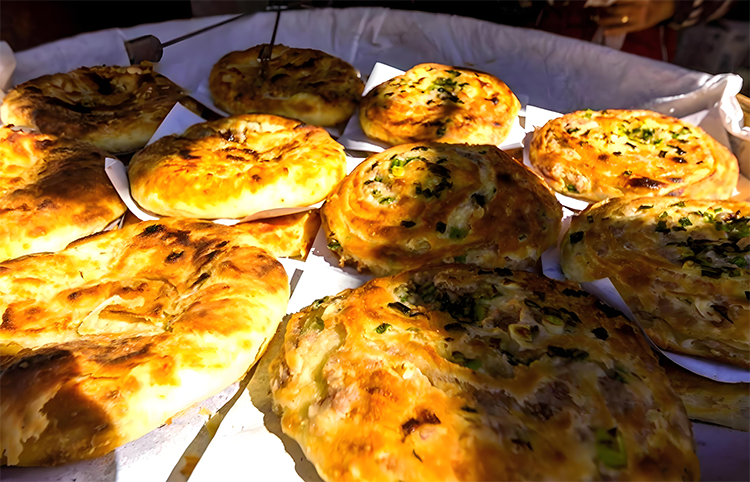Xizhou Baba: Dali’s Crispy Traditional Pastry — What It Is and Where to Try It
Intro
Stroll through Xizhou Ancient Town in Dali and the scent of toasted dough and caramelized sugar will guide you to a just-baked Xizhou baba. More than a snack, this layered pastry is a flavorful gateway to Bai culture and a taste of history dating back to the Tang dynasty.
1. Origin and History: From Court Delicacy to Local Treasure
Xizhou baba traces its prestige back to the Tang era when the Dali region was the center of the Nanzhao kingdom. Legend says its unique texture and aroma made it a favored delicacy at the royal court. Over centuries it moved from palace kitchens into village workshops in Xizhou, where local bakers adapted court refinement to humble, regional ingredients. Passed down through generations, Xizhou baba now stands as a beloved local specialty and an edible reminder of the region’s tea-horse road heritage.
2. Cultural Significance: Bai Hospitality on the Palate
In Xizhou, baba is more than food. It symbolizes hospitality and respect; serving hot baba to guests or during festivals is a high form of welcome. Its round shape represents reunion and fullness, while the many layers suggest richness and variety in life. Making and sharing baba at markets and celebrations strengthens community ties, and for visitors, tasting an authentic baba is a direct way to connect with Bai traditions and everyday local life.

3. Ingredients: A Blend of Mountain and Valley Flavors
The basic structure of baba is simple wheat dough, but its fillings celebrate Yunnan’s ingredient diversity.
– Savory version: uses local Nuodeng or Yunnan ham, diced to combine lean and fat, paired with rendered pork cracklings for crunch and savory depth. Aromatics like scallion or Sichuan pepper may be added for extra lift.
– Sweet version: relies on dark Yunnan brown sugar with its caramel notes, sometimes mixed with crushed walnuts or sesame for texture.
This local, contrasting sweet-and-salty approach reflects Yunnan’s inclusive culinary character.
4. Preparation: Craftsmanship in Every Layer
A great Xizhou baba depends on careful technique. Dough is kneaded with warm water until smooth, then left to rest and rise for airiness. The risen dough is rolled out, spread with filling, folded and rolled repeatedly to build dozens of visible layers. The rounds are then baked on a flat pan over charcoal or coals, with bakers balancing heat, turning and brushing oil until both sides are golden, puffed and fragrant. The result is all about timing and heat control.

5. Taste and Texture: Crispy Meets Tender
Just out of the oven is when baba is best. The thin outer crust snaps with a crisp, satisfying crack while the interior remains soft and layered. The savory baba blends salty ham, crunchy cracklings and wheaty sweetness without greasiness. The sweet baba lets brown sugar melt into each layer for a warm, rounded sweetness, often accented by nutty crunch. The contrast of crisp exterior and tender interior makes it unforgettable.
6. How to Eat and Tasting Tips
– Best time: eat it hot. Many Xizhou shops make baba to order, so watch the process and taste the first bite fresh.
– Pairing: savory baba suits a bowl of local butter tea to cut richness; sweet baba pairs beautifully with a cup of Yunnan pu-erh or green tea.
– Recommendation: if you can, try both savory and sweet to compare textures and flavors, or share with friends to sample more.

7. Where to Find It and Traveler Tips
– Where to eat: the most authentic baba is in Xizhou Ancient Town. Look around Sifang Street and the main thoroughfares for family workshops or long-standing shops with charcoal stoves outside.
– Price: very affordable, typically a few to a dozen yuan each, making it a great value food experience.
– Nearby activities: after tasting, visit the Yan Family Residence, try Bai tie-dye, or rent a bike to ride along Erhai Lake — food and scenery combine into a memorable Dali visit.
8. Home-Style Quick Recipe (A Tribute to the Classic)
While charcoal-baked baba is hard to fully reproduce, you can try a simplified home version:
1. Ingredients: all-purpose flour, yeast, diced ham or bacon, brown sugar, rendered lard or cooking oil.
2. Dough: mix flour, yeast and warm water, knead to smooth, and proof until doubled.
3. Fillings: dice ham; lightly break up brown sugar and optionally mix with a little flour to prevent runniness.
4. Assembly: deflate dough, roll into a sheet, spread a thin layer of lard, sprinkle filling, roll up and divide into portions, then flatten each into a round.
5. Cooking: brush a skillet with oil, pan-fry on low heat covered until golden and crisp on both sides.
Conclusion
Xizhou baba, born from the Nanzhao court and nurtured by Bai artisans, carries Dali’s centuries of flavor. With simple ingredients it delivers complex textures and memories. When you visit Yunnan, make time in Xizhou Ancient Town to follow the aroma to a freshly baked baba. That crunchy, tender moment will be one of your warmest, most authentic travel memories.


